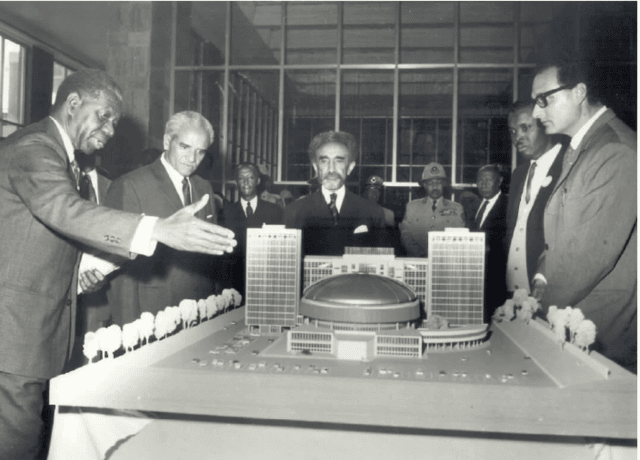 Afewerk Tekle’s iconic mosaic in Africa Hall, Addis Ababa, Ethiopia, meticulously restored and replaced by his grandson, Emmanuel Thomas. (Photo: Rory Gardiner via The Architect Newspaper)
Afewerk Tekle’s iconic mosaic in Africa Hall, Addis Ababa, Ethiopia, meticulously restored and replaced by his grandson, Emmanuel Thomas. (Photo: Rory Gardiner via The Architect Newspaper)
Tadias Magazine
By Tadias Staff
December 4th, 2024
TADIAS (New York) – Africa Hall, an iconic architectural and artistic treasure in Addis Ababa, has undergone a decade-long restoration to reclaim its glory as a beacon of Pan-African unity. Originally designed by Italian architect Arturo Mezzèdimi and completed in 1961, the building was a symbol of Ethiopia’s pivotal role in African history and home to the UN Economic Commission for Africa and the Organisation of African Unity (OAU).
A Tribute to Afewerk Tekle
At the heart of the restoration is the breathtaking mosaic by Ethiopian artist Afewerk Tekle, which has been fully replaced under the meticulous care of his grandson, Emmanuel Thomas. Known for his profound depictions of African themes and mastery in stained glass, Tekle’s work is revered as a celebration of Ethiopia’s cultural richness and resilience. The restoration of this masterpiece involved fabricating and reinstalling approximately 13 million new ceramic tiles to match the original mosaic.

Maitre Artiste Afewerk Tekle, Ethiopia’s most celebrated painter, speaking at Stanford University on March 7, 2004. (Photo: Tadias Magazine Archives, commemorating 20 years of storytelling).
Afewerk Tekle’s legacy is not just confined to Africa Hall. He is remembered as one of Ethiopia’s greatest artists, whose works captured the spirit of African identity and solidarity. His stained glass murals, which adorn the Plenary Hall, stand as a testament to the unity and diversity of the continent, echoing Emperor Haile Selassie’s vision when he commissioned the building.
Artistic and Architectural Renewal
The restoration team, led by Architectus Conrad Gargett, treated Africa Hall as a gesamtkunstwerk—a total work of art. Every element, from the architecture to the furniture, was approached holistically to honor the building’s original design while integrating modern functionality. The Plenary Hall, now equipped to host delegates from all 55 African Union member states, retains its radial ceiling, tiled columns, and distinctive 1960s charm.
Original artworks, such as Nenne Sanguineti Poggi’s murals and Ceramica Tebacchi’s floor mosaics, were restored and reinstated. Over 500 custom-designed furniture pieces by Mezzèdimi were also returned to their original positions, preserving the building’s mid-20th-century aesthetic.
A Modern Landmark

Africa Hall in Addis Ababa, Ethiopia, following its extensive restoration, a testament to modern heritage and artistic preservation. (Photo: Rory Gardiner)
Beyond its artistic restoration, Africa Hall has been modernized to meet contemporary needs. Sustainable practices under the UN’s “Greening the Blue” initiative were implemented, enhancing energy efficiency and accessibility. A new museum and exhibition space narrates the hall’s historic role in shaping modern African diplomacy, inviting visitors to connect with its legacy.
Ethiopia’s Place in History
Africa Hall is more than a building; it is a living monument to Ethiopia’s role as a leader in African unity and progress. Under Emperor Haile Selassie’s patronage, the hall became a cornerstone of the Pan-African movement, symbolizing a continent’s aspirations for independence, dignity, and collaboration.

Emperor Haile Selassie with the project team behind Africa Hall, captured ahead of its 1961 completion—a historic moment in Ethiopian architectural and Pan-African history. (Photo: Arturo Mezzèdimi Archive)”
Today, the restored Africa Hall stands as a tribute to the artistic genius of Afewerk Tekle, the architectural vision of Arturo Mezzèdimi, and the enduring aspirations of a united Africa. As it opens its doors once again, it invites the world to celebrate not just its beauty, but the profound history and cultural heritage it represents.
–
Related Read
For more details on the restoration and its broader architectural context, see The Architecture Newspaper: “Architectus Conrad Gargett renovates Africa Hall in Addis Ababa”
Join the conversation on Twitter and Facebook

























